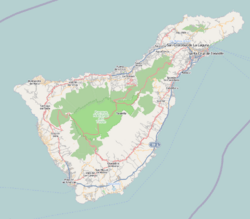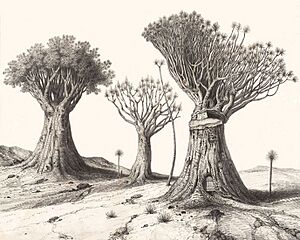La Orotava facts for kids
Quick facts for kids
La Orotava
|
|||
|---|---|---|---|
|
Municipality
|
|||

La Orotava
|
|||
|
|||
| Country | Spain | ||
| Autonomous community | Canary Islands | ||
| Province | Santa Cruz de Tenerife | ||
| Island | Tenerife | ||
| Area | |||
| • Total | 207.31 km2 (80.04 sq mi) | ||
| Population
(2018)
|
|||
| • Total | 41,833 | ||
| • Density | 201.790/km2 (522.633/sq mi) | ||
| Time zone | UTC+0 (GMT) | ||
| Post Code |
38300
|
||
| Climate | Csb | ||
| Website | www.villadelaorotava.org | ||
La Orotava is a beautiful town and municipality located on the northern side of Tenerife, one of Spain's amazing Canary Islands. It's a very large area, stretching from the coast all the way up to the mountains. This includes the top of the Teide volcano, which is the highest point in both the Canary Islands and all of Spain, standing tall at 3,718 meters.
Covering 207.31 square kilometers, La Orotava is the biggest municipality on Tenerife. In 2013, about 41,255 people lived here. The main town of La Orotava is found near the north coast, about 400 meters above sea level in the Orotava Valley. It's just 4 km southeast of Puerto de la Cruz and 28 km southwest of Santa Cruz de Tenerife, the island's capital. The TF-5 motorway also runs through the northern part of the municipality.
La Orotava's coat of arms was approved in 1906. It features dragoons (soldiers) guarding a dragon tree and golden apples. This refers to the old story of the Garden of Hesperides, which some people believed was located in La Orotava. The area is also famous for its wines, known as Denominación de Origen Valle de La Orotava.
In 1976, the historic center of La Orotava was recognized as a Conjunto histórico (a protected historical site). It's also part of the European Cultural Heritage Protection. A large part of the Teide National Park, a World Heritage Site since 2007, is within this municipality. La Orotava is known as one of Spain's highest and steepest towns, going from sea level right up to the 3,718-meter peak of Teide.
Contents
- What's in a Name? The Origin of La Orotava
- A Look Back: La Orotava's History
- How La Orotava Makes a Living: Economy and Tourism
- Exploring the Area: Subdivisions of La Orotava
- Population Growth: How La Orotava Has Grown
- Learning in La Orotava: Education
- Must-See Places: Sites of Interest in La Orotava
- Famous People from La Orotava
- La Orotava in Books
- Images for kids
- See also
What's in a Name? The Origin of La Orotava
It's not fully known where the name "La Orotava" comes from. However, many experts believe it came from the language of the Guanches, who were the original people of the Canary Islands. They might have called the area "Arautaba" or "Arautápala." It's thought that "Orotava" is a changed version of a Guanche word that was later used in the Spanish language.
A Look Back: La Orotava's History
The Guanches mainly lived along the coast and near the big canyons and hillsides in the valley. This was because they could easily find food and supplies there. For the Guanches, Mount Teide, the highest peak in Spain located in this area, was a very important place for worship.
When Spanish explorers, like Alonso Fernández de Lugo, arrived, the people of Tenerife fought back. Tenerife was the last of the Canary Islands to be conquered, which happened in 1496. The town of La Orotava officially began in 1502. This was when the land and water were divided among the soldiers who had helped in the conquest.
How La Orotava Makes a Living: Economy and Tourism
After the Spanish conquest in the 15th century, European settlers started an export economy. This meant a lot of goods and people moved in and out of the area for many decades. Early foreign visitors were quickly drawn to the pleasant weather and good conditions in the Taoro Valley.
La Orotava has very fertile land for farming. For centuries, its economy has relied on agriculture. Products like wine, tomatoes, and bananas were grown and sent mainly to Europe and the UK.
Tourism really started to grow in the early 1800s. La Orotava's beautiful natural surroundings attracted many researchers and wealthy visitors from Europe. During this time, La Orotava became a leading cultural spot. Many travelers and writers, including William Wilde and Alexander von Humboldt, stayed there.
Today, people from Northern Europe visit La Orotava all year round. It's especially popular during the winter months when the climate is mild, and around Christmas and New Year.
Exploring the Area: Subdivisions of La Orotava
The Orotava Valley stretches from the sea up to the mountains, reaching 2,000 meters high. It then continues up to Pico del Teide at 3,718 meters, which is Spain's tallest mountain. The valley includes the municipalities of Los Realejos, Puerto de la Cruz, and La Orotava. Together, these areas had a population of 111,606 at the start of 2023.
La Orotava is divided into several smaller areas. Some of these include El Rincón, La Florida, La Perdoma, San Antonio, La Luz, and Aguamansa.

Population Growth: How La Orotava Has Grown
| Year | Population |
|---|---|
| 1991 | 35,142 |
| 1996 | 35,642 |
| 2001 | 38,670 |
| 2002 | 39,095 |
| 2003 | 39,876 |
| 2004 | 39,909 |
| 2011 | 41,706 |
| 2013 | 41,255 |
Learning in La Orotava: Education
The British School of Tenerife has one of its campuses, called La Luz Campus, located in La Orotava.
Must-See Places: Sites of Interest in La Orotava
- El Ayuntamiento (town hall): The main building for the local government.
- Mirador Humboldt: A viewpoint named after Alexander von Humboldt. It offers amazing panoramic views of the valley.
- Casa Molina: A historic house.
- Plaza de San Francisco: A charming town square.
- La Casa de los Balcones: Famous for its beautiful wooden balconies.
- El Teide: Spain's highest mountain, great for hiking and exploring.
- Iglesia de La Concepción (church): A stunning example of Baroque architecture in the Canary Islands.
- Sociedad Liceo de Taoro: A cultural and social center.
Famous People from La Orotava
- Fernando Estévez – A talented sculptor.
- Dr. George V. Perez (1861–1920) – An Anglo-Spanish doctor who became a well-known local physician and botanist.
- Matías de Escobar y Llamas – A friar, speaker, and writer.
- Diego Rodríguez Fernández – A footballer who played for teams like CD Tenerife and Real Betis, and for the Spanish national team.
- Carlos Benites Franquis de Lugo (1691–?) – Served as the governor of Spanish Texas between 1736 and 1737.
- Luis Francisco Benítez de Lugo y Benítez de Lugo (1837-1876) – A politician, Freemason, and one of the first people to promote Spiritualism in Spain.
- Irene González Hernández (1969-2014) – A respected researcher and astrophysicist.
La Orotava in Books
La Orotava has been mentioned in several books:
- The English author Christopher Isherwood wrote about finishing his novel Mr Norris Changes Trains in La Orotava during the summer of 1934. You can read about it in chapter 10 of his autobiography, Christopher and His Kind.
- In chapter 37 of her novel "The Well of Loneliness", the English author Radclyffe Hall has her character Stephen Gordon suggest to Mary Llewellyn, "I'd like to get you right away for a bit, the weather seems pretty awful in Paris. Puddle once told me about Teneriffe, she went there ages ago with a pupil. She stayed at a place called Orotava; it's lovely, I believe – do you think you'd enjoy it?"
Images for kids
-
The bronze sculpture by the artist Ana Lilia Martín, born in La Palma (Canarias) in 1963, depicts the natural scientist Alexander von Humboldt. The sculpture has been on the terrace of the Humboldblick viewpoint in La Orotava since 2009
See also
 In Spanish: La Orotava para niños
In Spanish: La Orotava para niños



















